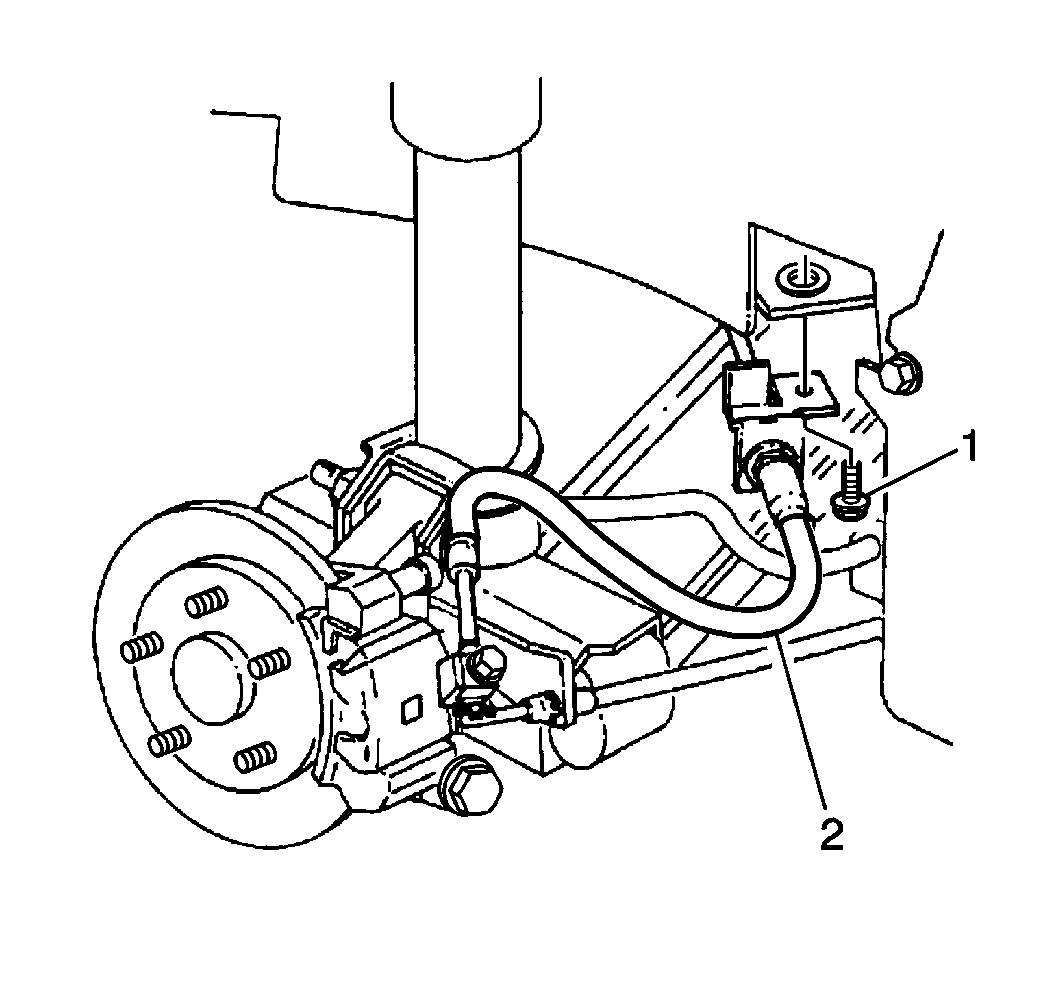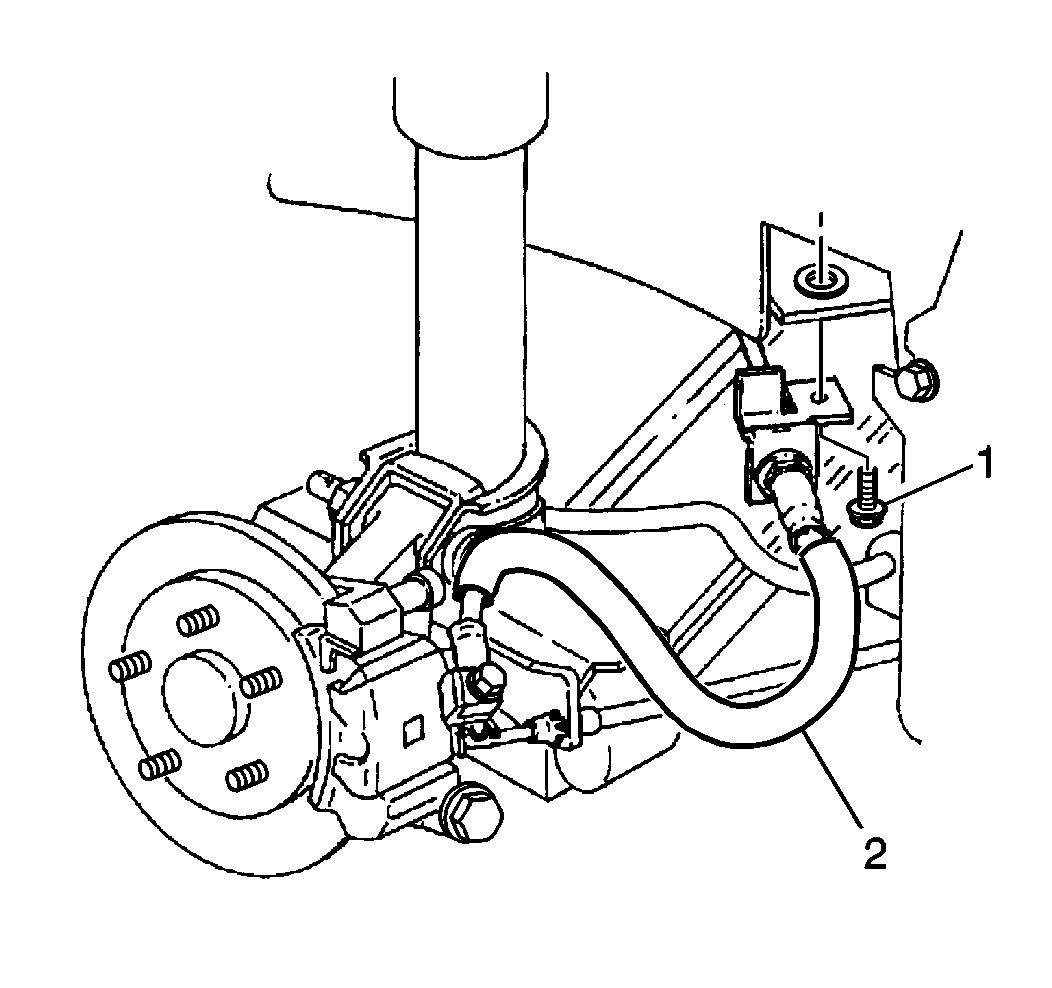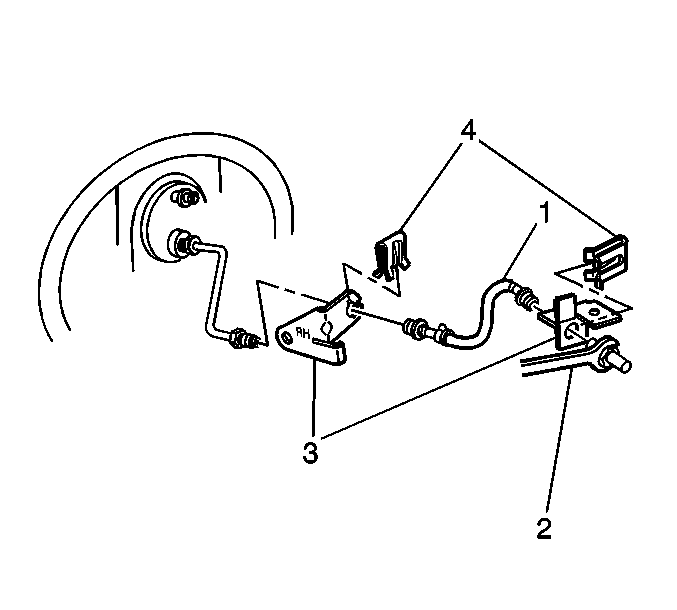Rear Brake Hose Replacement Disc
Removal Procedure
Caution: Do not move the vehicle until a firm brake pedal is obtained. Failure to obtain a firm pedal before moving vehicle may result in personal injury.
Notice: Do not allow components to hang from the flexible brake hoses as damage to the hoses may occur. Some brake hoses have protective rings or covers to prevent direct contact of the hose with other chassis parts. Besides causing possible structural damage to the hose, excessive tension could cause the hose rings to move out of their proper locations.
Notice: Brake hoses should not be crimped at any point, in order to prevent the loss of brake fluid from any component.
- Raise and suitably support the vehicle. Refer to Lifting and Jacking the Vehicle .
- Remove the tire and wheel. Refer to Tire and Wheel Removal and Installation .
- Clean all dirt and foreign material from the brake hoses and the fittings.
- Remove the bolt attaching the brake hose bracket (left-hand) to the rear strut.
- Remove the brake pipe (left-hand) from the brake hose. Use a backup wrench on the hose fitting. Do not bend the brake pipe or bracket.
- Remove the retainer from the brake hose at the bracket.
- Remove the hose from the bracket.
- Remove the brake pipe (right-hand) from the brake hose. Use a backup wrench on the hose fitting. Do not bend the brake pipe or bracket.
- Remove the retainer from the brake hose at the bracket.
- Remove the hose from the bracket.


Installation Procedure
- With the weight of the vehicle on suspension, install the brake hose into the bracket.
- Install the retainer onto the hose fitting at the bracket.
- Install the brake pipe (left-hand) to the brake hose. Use a backup wrench on the hose fitting. Do not bend the bracket or the pipe.
- Install the hose into the left-hand bracket.
- Install the retainer onto the hose fitting at the bracket.
- Install the brake pipe (left-hand) to the brake hose. Use a backup wrench on the hose fitting. Do not bend the bracket or the pipe.
- Install the bolt attaching the brake hose bracket to the rear strut.
- Install the tire and wheel. Refer to Tire and Wheel Removal and Installation .
- Lower the vehicle.
- Bleed the brakes. Refer to Hydraulic Brake System Bleeding .

| • | Ensure that there are no kinks in the hose. |
| • | Use the hose paint strip as a visual aid. |
| • | Align the hose fitting with the notch in the bracket. |

Notice: Use the correct fastener in the correct location. Replacement fasteners must be the correct part number for that application. Fasteners requiring replacement or fasteners requiring the use of thread locking compound or sealant are identified in the service procedure. Do not use paints, lubricants, or corrosion inhibitors on fasteners or fastener joint surfaces unless specified. These coatings affect fastener torque and joint clamping force and may damage the fastener. Use the correct tightening sequence and specifications when installing fasteners in order to avoid damage to parts and systems.
Tighten
Tighten the brake pipe fitting to 27 N·m (20 lb ft).
| • | Ensure that there are no kinks in the hose. |
| • | Use the hose paint strip as a visual aid. |
| • | Align the hose fitting with the notch in the bracket. |
Tighten
Tighten the brake pipe fitting to 27 N·m (20 lb ft).
Tighten
Tighten the brake hose bracket bolt to 25 N·m (18 lb ft).
Rear Brake Hose Replacement Drum
Removal Procedure
- Raise and suitably support the vehicle. Refer to Lifting and Jacking the Vehicle in General Information.
- Remove the rear tire and wheel assembly. Refer to Tire and Wheel Removal and Installation in Tires and Wheels.
- Clean dirt and foreign material from the brake hoses and fittings.
- Use a backup wrench (2) on the hose fitting in order to remove the brake pipes from the brake hose (1)
- Remove the retainer clips (4) from the brake hose at the brackets.
- Remove the hose (1) from the brackets.
Caution: Do not move the vehicle until a firm brake pedal is obtained. Air in the brake system can cause loss of brakes with possible personal injury.
Notice: Do not allow components to hang from the flexible brake hoses as damage to the hoses may occur. Some brake hoses have protective rings or covers to prevent direct contact of the hose with other chassis parts. Besides causing possible structural damage to the hose, excessive tension could cause the hose rings to move out of their proper locations.
Notice: Brake hoses should not be crimped at any point to prevent loss of brake fluid from any component.

Do not bend the brake pipes or the brackets (3).
Installation Procedure
- Install the brake hose (1) into the brackets (3).
- Use a backup wrench (2) on the hose fitting in order to connect the brake pipe to the brake hose (1).
- Do not bend the bracket or the pipe.
- Install the rear tire and wheel assembly. Refer to Tire and Wheel Removal and Installation in Tires and Wheels.
- Lower the vehicle.
- Bleed the brakes. Refer to Hydraulic Brake System Bleeding .
- Install the retainer clips (4) onto the hose fittings at the brackets.

There should be no kinks in the hose.
Align the hose fitting with a notch in the bracket. Use the hose paint stripe as a visual aid.
Notice: Use the correct fastener in the correct location. Replacement fasteners must be the correct part number for that application. Fasteners requiring replacement or fasteners requiring the use of thread locking compound or sealant are identified in the service procedure. Do not use paints, lubricants, or corrosion inhibitors on fasteners or fastener joint surfaces unless specified. These coatings affect fastener torque and joint clamping force and may damage the fastener. Use the correct tightening sequence and specifications when installing fasteners in order to avoid damage to parts and systems.
Tighten
Tighten the fittings to 27 N·m (20 lb ft).
